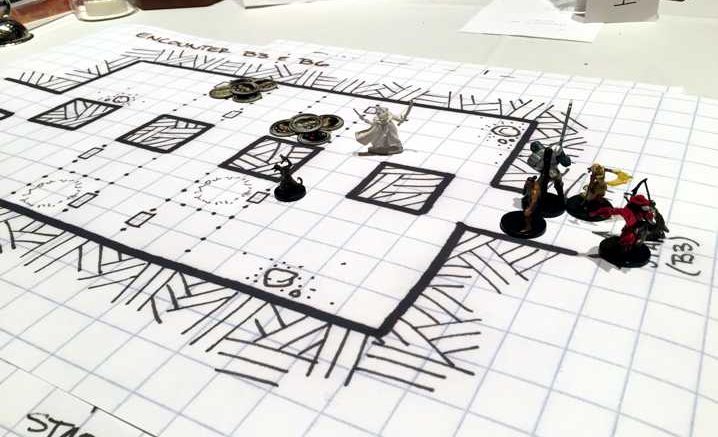The original Dungeons & Dragons game featured some activities that most players didn’t enjoy and eventually came to skip. I already wrote about mapping. Unless your group plays D&D in a deliberately old style, you don’t draft a player as a mapper who struggles to translate room dimensions to graph paper.
Spells with punishing side-effects qualify as another nuisance that D&D players learned to skip.
With some spells, players could simply avoid the side effects. The risk of instant death tends to limit teleportation to safe, familiar locations. And when Polymorph Other threatened system shock or a loss of individuality, party members never volunteered to fight in the form of a dragon.
Sometimes, avoiding side effects meant avoiding the spells. I’ve never seen anyone cast Contact Higher Plane. Apparently, few players like risking their character to a random chance of insanity.
Wish brought a mini-game where the dungeon master to tried grant the letter of the wish while perverting its spirit. Players countered by attempting to phrase their wishes to avoid any punishing interpretations. By third edition, players could skip the mini-game by selecting a wish from a menu of approved options.
A few irresistible spells included punishing side effects that DMs often ignored.
Haste aged its target a year, which forced a severe downside on humans, but an insignificant one on elves—and on humans in casual games without either bookkeeping or a reckoning of calendar years.
Lighting bolts could hit a wall and double back on the caster. When players started treating bolts as billiard balls and demanded to hit every foe using a trick shot, I suspect many DMs gave up on the bounce-back rule.
Fireball proved most popular and suffered the worst side effects. The original version risked blow back. “Fire Ball will generally conform to the shape of the space (elongate or whatever).” This meant a Fireball confined to small dungeon places could easily blow back and damage player characters. This drawback not only threatened PCs, but it also weighed the game with complicated volume calculations. D&D blogger and college mathematics lecturer Delta dutifully did the math. “After years of applying this, let me offer a heartfelt mathematician’s ‘Aaaarrgghh!!!’”
Worse than damage, Fireball destroyed treasure. “Besides causing damage to creatures, the Fireball ignites all combustible materials in the burst radius, and the heart of the Fireball will melt soft metals such as gold, copper, silver, etc. Items exposed to the spell’s effects must be rolled for to determine if they are affected.” Hitting PCs with collateral damage hurt enough, but players hated seeing treasure within their grasp destroyed.
Gary Gygax saw the the gotchas as a test of player skill and relished enforcing the punishments. His son Ernie recalled casting Fireball and how his father “would always let you know whatever cool thing you had destroyed. Normally it was difficult to figure out what anything was, but once it was destroyed, my dad would share. ‘Oh, it’s a real shame.’”
Few others saw the fun. Ernie Gygax found the lost treasure so bothersome that his wizard Tenser developed the spell Cone of Cold specifically to avoid the drawbacks of Fireball.
Faced with Fireball’s volume calculations, with item saving throws interrupting the game, and with the protests of players, many DMs just ignored Fireball’s side effects.
But without the gotchas, Haste, Lightning Bolt, and especially Fireball offered much more power. By Gary Gygax’s calculation, Cone of Cold—a replacement for Fireball without the punishing side effects—rated as a 5th-level spell.
The 5th-edition rules rewrite Haste, Lightning Bolt, and Fireball without the downsides. Haste now requires concentration and just targets one creature, so it loses some of its old power. Wizards seldom prepare Lighting Bolt because Fireball overshadows it. But Fireball keeps all the punch of a 5th-level spell with none of the downsides of its 3rd-level origin. When wizards gain the ability to cast Fireball, they leap in power.
Rather than dropping the power of the best spell available to 5th-level wizards, the designers of 5th edition gave every class some new ability that matches the Wizard’s leap in power. Fighters gain a second attack, Monks gain Stunning Strike, Rogues gain Uncanny Dodge, and so on. For more, see The obvious innovation in fifth-edition Dungeons & Dragons that no designer saw before. I suspect the designers boosted Hypnotic Pattern from a average 2nd-level spell to an powerful (and annoying) 3rd-level spell so Bards could match that leap in power.
By the way, Cone of Cold isn’t the only spell made to avoid a part of D&D that players preferred to skip. Originally, some of D&D’s strategy came from the job of hauling coins out of the dungeon. Players hired bearers and bought mules to help. Still, no one found encumbrance fun or baggage trains heroic, and Gary must have noticed. He created Tenser’s Floating Disk on behalf of Ernie and every other player who wanted a painless way to recover every last copper from the dungeon.
Article plucked from: http://dmdavid.com/tag/spell-blow-back-how-part-of-dd-that-everyone-avoided-shaped-the-5th-edition-power-curve/

Be the first to comment on "Spell Blow Back—How Part of D&D that Everyone Avoided Shaped the 5th-Edition Power Curve"